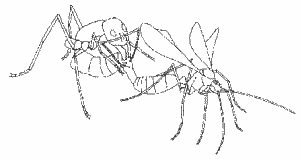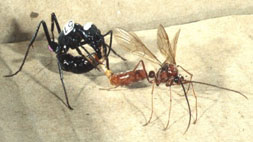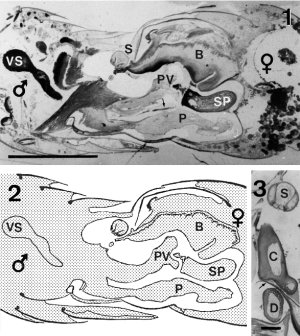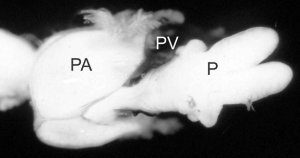While I am in danger of feeding my reputation as sexually fixated, I did want to put up one more post about weird mating systems before moving onto other non-sexual types of biology. I was taking a quick look at the literature after the post about spider genital breakage and came across an interesting paper on mating in queenless ants (Dinoponera quadriceps). These ants are really interesting in and of themselves and I think I’ll write more about them later. But for now, they have a pretty curious way of mating that manages to one-up the spiders.
When fertile, females of this species wait outside the nest each night waiting for a flying male to show up. When a male flies in, he courts her a bit and then they mate. After the successful coupling, the two remain stuck together while the female drags her suitor inside the nest. She then curls around and bites the males abdomen in half, leaving the male to die while she walks off with his genitals and the lower half of his body. Since this seems like a rather strange thing to do, two researchers (Moonin and Peeters) decided to investigate whether this amputation acted as a rather gruesome copulation plug preventing other males from mating. They found that other males were unable to mate while the severed body of their rival was blocking access and that by the time the female removed the male pieces about a half hour later she was no longer interested in sex. The female ants were never observed mating again.
While this may at first glance seem pretty detrimental to the male, males have little chance of finding another fertile female and the payoff for a successful mating is offspring for the entire life of the female so the male is well rewarded in the evolutionary sense although he doesn’t look too happy in this sketch of the female about to separate him from his lower half.

The sketches in the article were interesting but I had been hoping for pictures. Luckily, Monnin (the lead author) has a website covering his many studies of the queenless ant and includes the pictures the paper’s sketches were based off of and many other cool pictures.

If you were wondering what exactly is going on in the picture above, the biologists Allard, Gobin, Ito, Tsuji and Billen set out to answer your question. They decided to catch a similar species of ants in the act, cut a thin section out of the center of them and see how everything was connecting.

Their caption left me looking for a dictionary so I’ve inserted definitions in []’s:
Longitudinal section through copulating pair of Diacamma sp. showing male aedeagus [the whole male reproductive parts on the end of the abdomen] inserted inside female genital tract, and spermatophore (SP) [a packet of sperm] inside oviduct [passage from ovaries to outside]. Arrow points at strand connecting spermatophore to male gonopore [hole where sperm comes out]. Note cross section of sting (S), which is directed sideways by female during copulation. Scale bar: 1 mm.
Fig. 2. Schematical representation of fig. 1.
Fig. 3. Detail showing volsellar digitus (D) [bottom part of claspers for holding onto female] and cuspis (C) [top part of claspers for holding onto female] of male clasping the last sternite [the tail end of the abdomen] of female (arrow) during copulation. Scale bar: 100 um.
B: bursa copulatrix [insect vagina]; C: cuspis; D: digitus; P: inflated penis; PV: penis valves; S: sting; SP: spermatophore; VS: vesicula seminalis [sperm storage].
You may be wondering how they could cut such a thin slice out of a pair of ants. It turns out they fix the ants in place by submerging them in a clear plastic and then cut a tiny section through them with a double bladed saw. Reminds me of undergrad, when I had to do something similar when sectioning fish ear bones for aging.
If you were still curious, they also extracted the ant penis. I’m not too sure what the purpose of that was but if a trivia question ever asks how many lobes an ant penis has, we’ll now know the answer is 2.

The letters correspond to P: inflated bilobe penis; PA: paramere [case for penis when not in use]; PV: penis valve.
References
Monnin T. & Peeters C. 1998. Monogyny and regulation of worker mating in the queenless ant Dinoponera quadriceps Animal Behaviour. 55:299–306
Allard, D., Gobin, B., Ito, F. Tsuji, K. & Billen, J. 2002. Sperm transfer in the Japanese queenless ant Diacamma sp. Netherlands Journal of Zoology. 52:77-86
Alex | 25-Apr-07 at 8:46 am | Permalink
Thank You
maleok | 26-Jul-10 at 1:35 am | Permalink
very interesting relaships between males and females in ants
John | 07-Aug-10 at 12:50 am | Permalink
I never knew that female ants were so vicious. Definitely will stay away from them. I do not wish to have my bottom half of my torso removed and be left there to die slowly.
Nature does have some very unique little traits.
Bigger | 07-Aug-10 at 12:52 am | Permalink
I am very proudly male and extremely happy that I am not an ant or a spider. Females (In Nature) are really horrible.
David | 01-Dec-10 at 9:13 pm | Permalink
very interesting relaships between males and females in ants
Jim from Male Enhancement Tips | 31-Dec-10 at 9:34 am | Permalink
Thanks for sharing this revealing study. But I wonder silently: “Does it mean if I were created an Ant of this specie, I would have DIED long ago after my first sex?”
Now it’s good to be human and not one of those killer female ants that mate once in a life time.